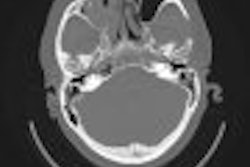U.K. clinicians have determined that routine chest x-ray after thoracentesis is not necessary. They conducted a retrospective case study on the diagnostic utility of radiographs after this fluid-removing surgical procedure.
"Routine chest radiographs immediately after needle thoracentesis is a standard practice ... usually done to exclude a possible complication," such as pneumothorax or hemothorax, explained Dr. Sujoy Khan and colleagues in their poster presentation at the 2005 RSNA meeting in Chicago. Khan's group is from Llandough Hospital in Cardiff, Wales.
But the incidence of postprocedural pneumothorax on chest radiography ranges from 4% to 30%, while the incidence of hemothorax is around 1%, the authors stated.
For this study, they included 87 patients and 100 thoracentesis procedures performed between January 2004 and February 2005. Chest x-rays were obtained postprocedurally at the request of referring physicians. Patient demographics, indications for thoracentesis, use of ultrasound guidance, level of training, x-ray interpretation, and eventual patient outcome were recorded.
According to the results, the mean age of the predominantly male patients was 71.4 years. A common indication for aspiration was infection followed by cancer. Fourteen of the 100 procedures were performed after using ultrasound for marking. There was one case of ultrasound-guided needle aspiration.
A complication was suspected in four procedures but immediate chest x-ray showed only one complication. Overall, 58 chest x-rays were performed and they revealed two cases of pneumothorax. The most common complications were shortness of breath, hypotension, and aspiration of air.
"There were 96 procedures with no clinical suspicion or indication of a complication and one pneumothorax occurred," the group wrote. "The complication rates were 25% for those with clinical symptoms and 1% without clinical symptoms. Fifty-four (93%) chest roentgenograms were performed without a clinical indication and one complication (1.8%) was reported."
Of the two patients who did have pneumothorax, one underwent simple aspiration but the other did not require more invasive management, they added. Finally, level of training and incidence of complications were not statistically significant.
"No post-thoracentesis radiographs demonstrated additional findings unrelated to the procedure performed," Khan's group stated. "Our study show that routine chest radiography is not indicated immediately after routine thoracentesis. Clinical symptoms did not correlate to the development of pneumothorax or hemothorax."
These findings bolster previous research that did not find x-ray after thoracentesis to be of great value. Spanish investigators studied the risk factors for complications from diagnostic or therapeutic thoracentesis in cirrhotic patients with pleural effusion. In their data, chest radiography and clinical follow-up were performed in 69 patients within 24 hours of the procedure. The most severe complication was pneumothorax, but in only 4% of the cases.
They also found that the actuarial risk of pneumothorax after the first therapeutic thoracentesis was 7.7%, with the risk increasing after additional procedures, thereby requiring immediately chest x-ray. However, they stated that chest x-ray was not justified after a diagnostic thoracentesis (Revista Española de enfermedades digestivas, September 2001, Vol. 93:9, pp. 566-575).
By Shalmali Pal
AuntMinnie.com staff writer
December 26, 2005
Related Reading
CT doesn't hurt when evaluating emergency chest pain, August 15, 2005
Studies critique radiologists' reports in chest x-ray, knee MRI, April 19, 2005
ATS publishes standard-of-care guide for community-acquired pneumonia, February 16, 2005
Copyright © 2005 AuntMinnie.com



















